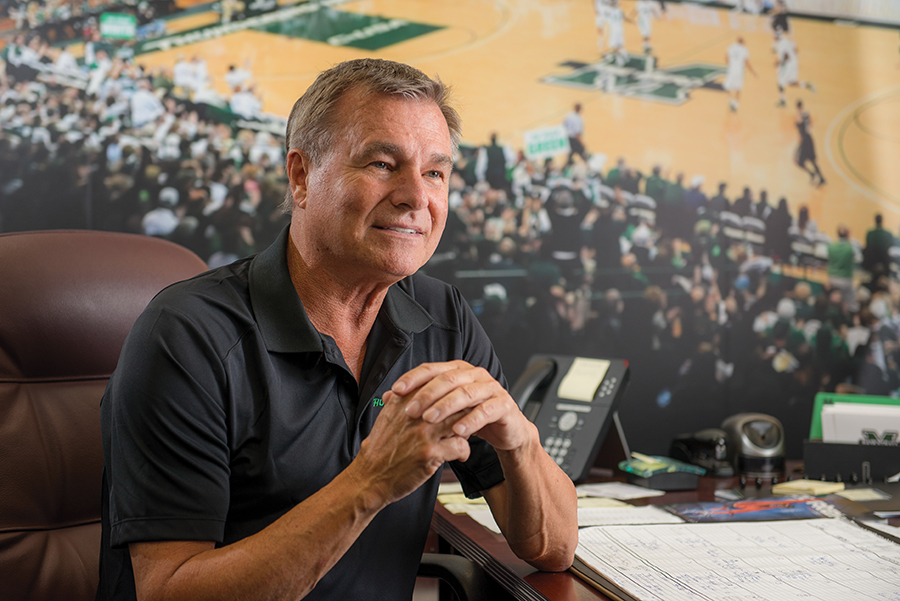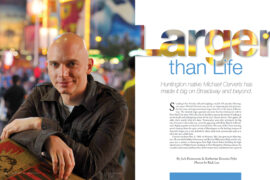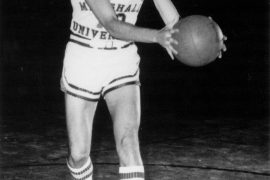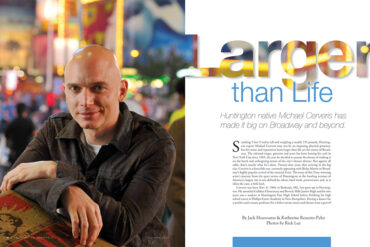Coach Dan D’ Antoni on his college career, the Iron 5, the Memorial Field House, the politically charged 1960s and this year’s Thundering Herd squad.
Interview by Keith Morehouse
HQ 91 | AUTUMN 2015
It’s easy to see how Dan D’Antoni has settled into his job as head coach of the Marshall men’s basketball program. It’s 8 a.m. on a summer day and D’Antoni’s sporting blue jeans and flip flops. His green T-shirt is emblazoned with a Marshall logo inside an image of the state of West Virginia. Clearly he’s fond of his state and his school.
Dan D’Antoni is a proud son of Mullens, West Virginia, where the D’Antoni name has become legendary. He was a star player for the Mullens Rebels before heading to Huntington to play for Ellis Johnson and the Thundering Herd. After a Hall of Fame career playing for the Thundering Herd from 1967-1970, D’Antoni came back to coach his alma mater. In between there was a long coaching stint at Socastee High School and then on to the NBA where he was an assistant to his brother, Mike, with the Phoenix Suns, New York Knicks and the Los Angeles Lakers.
D’Antoni’s first season with the Herd ended with an 11-21 record. He has revamped the roster and brought an upbeat, perimeter-based offense, which is predicated on movement, spacing and outside shooting.
Huntington Quarterly contributor Keith Morehouse sat down with D’Antoni to ask him about growing up in Mullens, his glory days at Marshall, the politics of the 1960s, and a coaching career that has brought him full circle back to West Virginia.
How did you find your way from Mullens to Marshall?
My uncle, Andy D’Antoni, had played at Marshall. Back then Marshall was like California, a long way from Mullens. You really lived inside your own sphere. I had dreams of playing in college somewhere but no real path on how to get there. We were playing against Pineville High School and Ellis Johnson came down to see Dallas Blankenship play, who was a very good high school player at Pineville But somehow I must have caught Ellis’ eye. After the game they said, “There’s a coach here to see you.” I didn’t know who he was to be honest with you. Coach said, “I came here to see Dallas Blankenship but I came to this locker room first because I want you to be my point guard for the next four years.” Considering I had no other offers I said, “Yes.”
What was the atmosphere like at the Memorial Field House in the late 1960s?
You could feel the fans’ passion and that created a great atmosphere – there’s no question. We created a buzz and started getting some national attention. We were out to prove something and people rallied behind us. We got a lot of support from a lot of prominent local businessmen like Doc Hagley and Dr. Gerry Vanston and Dr. Pete Proctor – they all wanted us to be successful. Their entertainment came through basketball and their passion drove our passion. The fans made us feel so special and we wanted to play well for them. It was a family atmosphere, but it was loud in there. Those were great times.
Tell us about your teammates from 1967-1970 and why did the press call you the “Iron 5?”
Ellis Johnson wasn’t a substitute coach – once you got on the floor you were on the floor. The lineup was Bob Allen, George Stone, Bob Redd, Jim Davidson and myself. If we weren’t way ahead and you didn’t get in foul trouble you didn’t come out. I loved it. I didn’t want to come off the floor because I was afraid someone was going to take my job – so we became the Iron 5.
A reliable source told us there was one occasion when you were kicked off the team, but George Stone went to the coach and got you reinstated. Is that true?
Oh boy. [Laughs] We were in New York for a tournament and friends from Huntington were coming to the hotel. They didn’t have anywhere to stay and it was like 4 a.m., so we ended up letting some people crash in our room. Well, Ellis did a room check and said, “We just can’t have this.” He said he was going to kick me off the team. But George pulled him aside and said, “You can’t do that. We couldn’t turn all these people away.” It was a little more innocent than everyone thinks it was.
What are your memories of playing with George Stone, whom the late Ernie Salvatore called one of the five greatest Marshall players of all time?
He didn’t put the ball on the floor. He was a spot up player who could shoot quickly and he was tough. He took a liking to me because I could do the dribble in his game and get him the ball where he needed to have it. He liked to play board games and I liked to play board games – Scrabble and Monopoly – and we would play cards together. We just liked doing those things and we formed a bond. I think our games complemented each other’s and it worked out well.
What were some of your big games that you remember?
I’m not big on stats, but if I remember correctly I had a big game against Houston – 24 points, 12 rebounds and nine assists. They were ranked No. 1 and we played them in Madison Square Garden. I had a big game against Nebraska and that was right after Ellis threatened to kick me off the team, so I made sure I played well and stayed.
The late ’60s saw some rather colorful and unique fashion trends. Were you a sharp dresser and what do you recall wearing back then?
I was from Mullens and we were limited in apparel. My idea of cool was blue jeans, a T-shirt and a letter jacket. I tried. I remember Pat Brady (former Herd player) became my roommate and he was a dresser. He had some of those beautiful platform shoes. I thought he was cool. So I went out and bought me a pair of candy apple red platforms. But, I would only wear them in my room. I was never brave enough to wear them in public.
The Civil Rights movement was just winding down during your years at Marshall. What do you recall about that time in Huntington?
They said George and I were the first black-white roommates at Marshall. We weren’t trying to do anything, it was just two guys that played together and liked each other. I think people tried to make more of it than there was. George lived it all his life. He was probably the only black guy in a white area many times. Once I felt like they respected us, and you were a fair-minded person, there weren’t a whole lot of problems.
Were there protests about the Vietnam War on campus?
They had a big protest down at Old Main. There was a furniture store to the right and the students had gathered there. I just went down to see what was going on. I was on a bike. They brought in an elite team of state troopers. They formed a wedge. There were probably 1,000 students there and they shot some tear gas over top of me. I turned around and I saw this wall of tear gas coming back toward me and back toward the students. I took off and the state police were picking off kids running that way. But I was just far enough away to get out of there or I would have been caught up as a protestor, which I wasn’t. I was a watcher!
You have gone from Mullens to coaching and traveling around the world. In your opinion, how has the world changed since 1970?
I think kids went outside more back then. Now there’s social media and portable video games. Back then people rubbed elbows more, flesh to flesh instead of thumb to wire to thumb. That changes your ability to relate to people. I used to say to dad, “It didn’t seem like we had a lot of money,” and dad said, “We had enough.” There wasn’t the stress that finances seem to put on people nowadays. Entertainment was cheap because it was basically getting together with people.
What’s it been like competing and coaching in the NBA with your brother Mike? And tell us about your philosophy of coaching?
It came naturally. It wasn’t anything we had to work at. We competed as kids but there was no jealousy. Mom used to say, “Winning has a price and there are some prices you don’t pay to win,” such as cheating and ruining relationships in order to win. We’re competitors bu there is a price I won’t pay to win. I think life holds a little bit more to it than just winning and losing.
What can the fans expect this season from the Thundering Herd?
A faster-paced game. A lot of the offense will be the same, but I think it will be a quicker pace. And on defense we will be adding lots of pressure and trapping.Our team will start the defense immediately when the opponent has the ball.
Who are some of the players to watch this season?
To start, we have some returning players that will be exciting to watch – Justin Edmonds, Austin Loop and Ryan Taylor. We have senior James Kelly, who is extremely talented.Then we have a slew of newcomers including three West Virginians – Jon Elmore, Stevie Browning and C.J. Burks. And we expect improvement from foreign recruits Ajdin Penava and Aleksandar Dorzic. So from top to bottom the level of play will be vastly improved this year.
What are your long-term goals for the Marshall basketball program?
I want a quality program with quality kids. And I want a program that will put up a lot of “Ws.” A lot of wins that will get the fan base excited. But I want the fans to be proud not only of a winning team, but the types of individual players we have as well. I want to recruit young men who will be real student athletes; that will one day become good alumni who will come back and support this program. That’s what Huntington, Marshall and West Virginia deserve.





